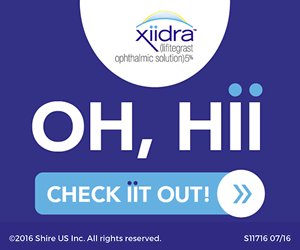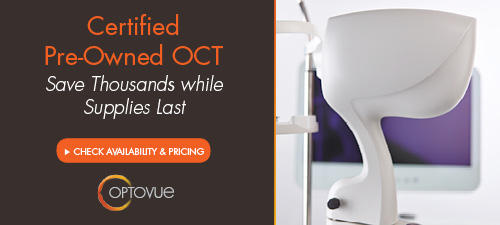
A
weekly e-journal by Art Epstein, OD, FAAO
Off the Cuff: New Beginnings
After spending the better part of last week in Washington, DC at the AOA meeting, I have a few thoughts to share. First, humble and sincere thanks to the many colleagues who came up to chat, share their perspective or just say hello. Meeting and talking to colleagues is always a treat. Added to that, the mood at this meeting was especially encouraging.
|
|||||
|
|||
| Brand Medications and Medicare Part D: How Eye Care Providers' Prescribing Patterns Influence Costs | ||||
This study quantified costs of eye care providers' Medicare Part D prescribing patterns for ophthalmic medications and to estimate the potential savings of generic or therapeutic drug substitutions and price negotiation. The Medicare Part D 2013 prescriber public use file and summary file were used to calculate medication costs by physician specialty and drug. Savings from generic or therapeutic drug substitutions were estimated for brand drugs. The potential savings from price negotiation was estimated using drug prices negotiated by the United States Veterans Administration (USVA). Main outcome measures included the total cost of brand and generic medications prescribed by eye care providers.
Eye care providers accounted for $2.4 billion in total Medicare Part D prescription drug costs and generated the highest percentage of brand name medication claims compared with all other providers. Brand medications accounted for a significantly higher proportion of monthly supplies by volume, and therefore, also by total cost for eye care providers compared with all other providers (38% vs. 23% by volume, p<0.001; 79% vs. 56% by total cost, p<0.001). The total cost attributable to eye care providers is driven by glaucoma medications, accounting for $1.2 billion (54% of total cost; 72% of total volume). The second costliest category, dry eye medications, was attributable mostly to a single medication, cyclosporine ophthalmic emulsion (Restasis, Allergan), which has no generic alternative, accounting for $371 million (17% of total cost; 4% of total volume). If generic medications were substituted for brand medications when available, $148 million would be saved (7% savings); if generic and therapeutic substitutions were made, $882 million would be saved (42% savings). If Medicare negotiated the prices for ophthalmic medications at USVA rates, $1.09 billion would be saved (53% savings). Researchers concluded that eye care providers prescribed more brand medications by volume than any other provider group. They suggested that efforts to reduce prescription expenditures by eye care providers should focus on increasing the use of generic medications, primarily through therapeutic substitutions and that policy changes enabling Medicare to negotiate prescription drug prices could decrease costs to Medicare. |
||||
SOURCE: Newman-Casey PA, Woodward MA, Niziol LM, et al. Brand medications and Medicare Part d: How eye care providers' prescribing patterns influence costs. Ophthalmology. 2017; Jun 16. [Epub ahead of print]. |
||||

|
||
| Comparison of Efficacy of Difluprednate 0.05% and Loteprednol Gel 0.5% After Cataract Surgery | ||||
This study compared the outcomes and complications of topical difluprednate 0.05% and loteprednol gel 0.5% after routine cataract surgery. Subjects received either difluprednate emulsion 0.05% (n=30 eyes) or loteprednol gel 0.5% (n=30 eyes) after routine cataract surgery. Topical steroid drops were initiated three days before cataract surgery and continued for two weeks postoperatively. Anterior chamber (AC) cell grade, corneal edema, corneal pachymetry, visual acuity, ocular surface quality (Oxford scale) and intraocular pressure (IOP) were evaluated at one day, one week and one month postoperatively.
Patients treated with difluprednate or loteprednol had statistically similar resolution of their AC cell grade and corneal edema at one day, one week and one month postoperatively (p>0.05 at each study visit). Difluprednate-treated and loteprednol-treated eyes achieved a mean best-corrected visual acuity of at least 20/25 by one week postoperatively (0.055 and 0.061 logarithm of the minimum angle of resolution, respectively). The nasal ocular surface quality at one week had improved in loteprednol-treated eyes compared with difluprednate-treated eyes (1.0 vs. 1.9 Oxford score, respectively), but similar at all other visits. There was no statistical difference between IOP levels between both treatment groups. In the difluprednate-treated group, one patient developed rebound inflammation, and two patients developed cystoid macular edema at their one-month postoperative visit. The anti-inflammatory effect, visual recovery and IOP of patients using topical difluprednate or loteprednol gel after cataract surgery were equivalent. Investigators found that there may be an additional short-term benefit of loteprednol gel in protecting the ocular surface after cataract surgery. |
||||
SOURCE: Abessi B, Brooksby L, Schultze RL. Comparison of efficacy of difluprednate 0.05% and loteprednol gel 0.5% after cataract surgery. Eye Contact Lens. 2017; Jun 16. [Epub ahead of print]. |
||||
 |
||
| Shifting of the Line of Sight in Tilted Disk Syndrome | ||||
Eighty left eyes of 80 subjects with TDS (study group) and 70 left eyes of 70 subjects with myopia and astigmatism (control group) were included in this study to investigate the shifting of the line of sight (LoS) and the refractive, topographic, and aberrometric parameters that may be associated with the shifting of the LoS in eyes with tilted disk syndrome (TDS). Line-of-sight coordinates on the horizontal (x) and vertical (y) axes, and refractive, topographic and aberrometric parameters were evaluated. All parameters were compared between groups, and correlations were analyzed for the study group.
In the study group, the LoS significantly shifted to the superotemporal direction compared with the control group. The shift on the y-axis was correlated with mean cylindrical refractive error, total root mean square (RMS), higher-order aberration RMS, vertical coma and vertical trefoil values. Results demonstrated a superotemporal shifting of the LoS in eyes with TDS. Researchers wrote that this shift must be accounted for to prevent decentralization and provide satisfactory outcomes, as eyes with TDS have an important place among candidates for refractive and multifocal intraocular lens implantation surgeries. |
||||
SOURCE: Kosekahya P, Sarac O, Koc M, et al. Shifting of the line of sight in tilted disk syndrome. Eye Contact Lens. 2017; Jun 16. [Epub ahead of print]. |
||||
 |
||
| News & Notes | |||||||||
| Shire Names Snisarenko to Succeed Dempsey as Head of U.S. Ophthalmics Shire announced that John Snisarenko was named group vice president and head of ophthalmics in the United States. He succeeds Robert Dempsey, who is now vice president and head of global ophthalmics at Shire. Snisarenko brings 30 years of experience in the pharmaceutical, biotech and medical device industries. Most recently, Snisarenko was vice president of sales and marketing for rheumatology at Genentech, where he worked on Actemra and Rituxan drugs. Prior to that, he led sales and marketing for Genentech ophthalmology in the United States. There, he was part of the team that introduced the “Commitment to Retina” initiative, and was involved with the Lucentis product. Earlier in his career at Novartis Pharma Canada, Snisarenko led the integration of the ophthalmology business from CIBA Vision to Novartis Pharma. He also led the Canadian launch of the unit’s first bio-pharmaceutical medicine, Visudyne.
|
|||||||||
| Menicon Introduces Additional Base Curve for Miru 1day Flat Pack Contact Lenses Menicon America introduced a second base curve for their Miru 1day Menicon Flat Pack daily disposable contact lenses. Miru 1day Flat Pack is now offered in an 8.4 base curve in addition to the existing 8.6 base curve. The 1day Miru 8.4 base curve was designed based on direct feedback from ODs who expressed an interest in additional base curve options for their patients. In conjunction with OD partners, company leaders wanted our daily disposable patients to benefit from a customized fit that could only be achieved by offering a second base curve. Miru 1day Menicon Flat Pack 8.4BC lenses are available in trial six-packs, 30 packs and 90 packs. Read more.
|
|||||||||
| Novartis Announces Positive Results for RTH258 (Brolucizumab) Novartis announced positive results for RTH258 (brolucizumab) from the findings of two Phase III studies, HAWK and HARRIER. RTH258, a single-chain antibody fragment enabling delivery of a high molar dose, that could potentially help individuals with neovascular age-related macular degeneration who would benefit from a long-lasting treatment with less frequent dosing. RTH258 (brolucizumab) 6 mg reportedly met primary and key secondary endpoints in both studies, and RTH258 3 mg, evaluated in HAWK, also met the endpoints. The studies enrolled more than 1,800 individuals worldwide with nAMD. The primary and key secondary efficacy endpoints were non-inferiority of RTH258 to aflibercept in mean change in best-corrected visual acuity from baseline to week 48, and average mean change over the period of week 36 to 48, respectively. Both endpoints were met with highly significant p values. Detailed analysis of the data is ongoing and will be presented at an upcoming medical congress. Novartis expects to complete the final manufacturing process to enable filing in 2018. Read more.
|
|||||||||
| Johnson & Johnson Vision Introduces Advocacy Academy Johnson & Johnson Vision Care’s new Advocacy Academy, an on-demand, virtual learning tool to educate and mobilize a new community of eye health advocates to engage with lawmakers, agencies and patient associations on key issues impacting eye health, is the latest addition to the company’s Vision to Action advocacy efforts. The self-paced modules are designed with generational learning styles in mind and provide guidance to eye health professionals who have an interest in sharing their expertise and insights with lawmakers, agencies and associations to effectively advocate for policies that put patients first. Coinciding with the launch of Advocacy Academy, Johnson & Johnson Vision has also revamped its online home for eye health advocacy information, Vision to Action, formatting the site for easier search and quicker access to the most relevant resources. Read more. |
|||||||||
| Avedro Names Griffin as CFO Thomas E. Griffin, Avedro’s new chief financial officer, has more than 25 years of executive management experience at emerging growth medical technology companies. Griffin spent his entire career in financial operations at medical technology and biotechnology companies. For 10 years and during the company’s initial public offering, he served as CFO of Entellus Medical before transitioning to vice president of finance in May 2016. Prior to that, Griffin served in a variety of executive level financial positions at several organizations, including Digital Gene Technologies, Centerpulse Spine-Tech (now Zimmer Spine), and CIMA Labs (now owned by Teva Pharmaceutical Industries). He is a member of Helius Medical Technologies’ board of directors, where he is chairperson of the audit committee. Read more. |
|||||||||
|
Optometric Physician™ (OP) newsletter is owned and published by Dr. Arthur Epstein. It is distributed by the Review Group, a Division of Jobson Medical Information LLC (JMI), 11 Campus Boulevard, Newtown Square, PA 19073. HOW TO ADVERTISE |





